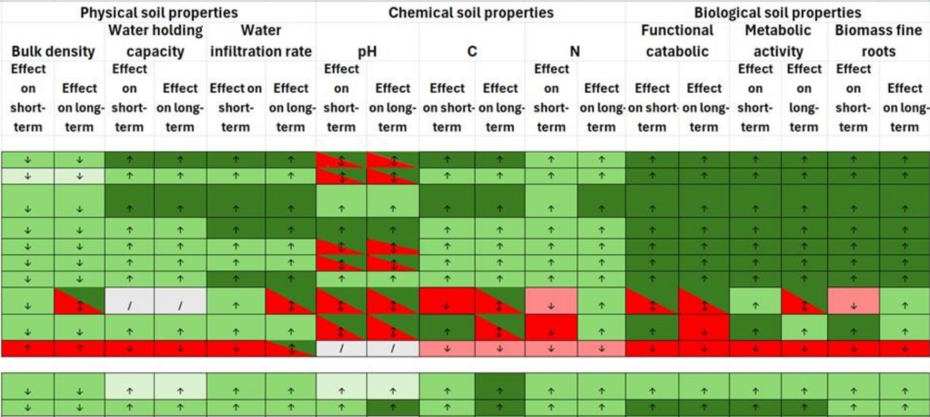Best Practice Knowledge Base
5. Enhancing Soil Health/Soil Preparation

Enhancing soil health through proper soil preparation is a crucial aspect of forest restoration, as it establishes the essential conditions for the successful growth and development of target plantspecies.
This process involves improving soil structure, increasing organic matter content, and fostering a balanced microbial community, all of which contribute to better water retention and nutrient availability. By addressing these factors, soil preparation ensures robust root systems and promotes plant resilience against environmental stresses. Adequate soil health not only supports the immediate needs of newly planted seedlings but also facilitates long-term ecological stability, enabling restored forests to effectively sequester carbon, sustain biodiversity, and maintain ecosystem functions.
The following sections described the specifics on what to restore to improve soil health and summarise the multiple restoration techniques influencing soil health. Some of these techniques as further detailed in the corresponding sections.
5.3 Soil amendments
Soil amendments are materials added to soil to improve its physical, chemical, or biological properties, enhancing conditions for plant growth. Common amendments include organic matter like compost or biochar, which enrich nutrient content and improve water retention, and mineral additives like lime or gypsum to adjust pH and soil structure. Specifically, they can help degraded soils regain fertility, support microbial communities, and increase seedling survival rates. For their application it is crucial to consider the local soil conditions, amendment compatibility with native ecosystems, and potential environmental impacts to ensure their effectiveness and avoid unintended consequences.
5.4 Soil fertilization
Soil fertilization is used to enhance soil fertility and nutrient availability, which are critical for promoting the successful establishment and growth of vegetation in degraded or nutrient-poor soils. By replenishing essential nutrients such as nitrogen, phosphorus, and potassium, fertilization can accelerate forest recovery, support biodiversity, and improve soil structure. However, it must be carefully managed to avoid negative side effects, such as nutrient imbalances, water pollution, or harm to native species. The use of fertilizers and techniques adequate to specific site conditions and restoration goals, is essential to ensure that fertilization contributes positively to long-term ecological restoration outcome.
5.5 Rockdust application
Rockdust application, also often called remineralization, involves amending soils with finely ground silicate rocks to replenish essential minerals and counteract soil acidification. This method enhances soil fertility by slowly releasing nutrients such as calcium, magnesium, and potassium, which are vital for plant growth and overall ecosystem health. The gradual weathering of rock dust improves nutrient availability and increases the soil buffer capacity, making it particularly beneficial for restoring degraded or acidified forest soils. Research in European contexts shows that rockdust application can improve soil nutrient status and support target vegetation development. Its effectiveness depends on factors like rock type, particle size, and site-specific soil properties, among others.
5.6 Tilling/plowing
Tilling or plowing is employed in forest restoration to alleviate soil compaction, enhancing soil aeration and water infiltration. This facilitates root penetration and supports the establishment of vegetation. Additionally, plowing can incorporate organic matter into the soil, modifying its structure and fertility. However, this method must be applied carefully to prevent potential adverseeffects, such as erosion or disruption of soil microbial communities. Therefore, it is often integrated with other restoration strategies.
5.7 Topsoil removal
Topsoil removal is a restoration technique in which the uppermost soil layer is stripped away to reduce excessive nutrient levels, particularly nitrogen and phosphorus, which can hinder the re-establishment of native vegetation. This method is especially used in sites where high nutrient concentrations favor competitive species that outcompete native flora, like grasslands or heathlands. By removing this topsoil we can improve the conditions for the germination and growth of target species, promoting the recovery of natural plant communities. However, this approach can also disrupt soil fauna and microstructure. Thus, a careful consideration of potential ecological impacts and complementary measures are needed.
5.8 Diluting soil contaminants
By diluting the concentration of the pollutant in order to facilitate degradation processes, a more even distribution of contaminants can be achieved throughout the soil profile, thereby lowering contaminant concentrations. This can help improve the conditions for vegetation establishment and growth, thereby supporting ecosystem recovery. However, this approach may not eliminate all contaminants and may pose risks of spreading pollutants. Therefore, it is often combined with other remediation strategies, such as bioremediation, to effectively restore soil health.
5.9 Introduction of litter-rich species
When facing low soil fertility and acidification, tree species can be introduced whose leaf litter is high in essential nutrients, particularly base cations like calcium, magnesium, and potassium. When the nutrient-rich litter from these species decomposes, it releases cations that increase soil pH and improve nutrient availability, which in turn creates a better environment for plant and microbial communities. This can promote faster nutrient cycling and support higher biomass of soil organisms.
5.1 What to restore?
Before restoring forests and soils, it’s vital to understand their roles in ecosystem health and the impacts of forest degradation on soil. Forests and soils are tightly linked and should be managed as one system. Restoration is context-dependent, shaped by local conditions and land-use history. Here we propose a set of indicators for soil physical, chemical and biological properties, some of which are considered ‘scalable’, i.e. designed to be applicable across diverse ecosystems, cost-effective, and easy to implement.
5.2. How to restore?
Soil is both an integral and essential part of the forest ecosystem and a critical component that requires specific attention and management. Multiple forest restoration strategies are explicitly targeted on soil health, while some others can indirectly impact soil health.
Related resources
Forest and Soil Restoration Table
An Excel table that outlines various forest restoration measures and their effects on key soil parameters. This table offers a practical overview for assessing the benefits and limitations of different approaches to forest and soil restoration. Colours indicate a positive or negative effect, while the arrows indicate if there is an increase or decrease of the soil properties. When interpreting this table, it is important to consider that factors like previous land use and implementation quality can strongly influence soil recovery outcomes.




